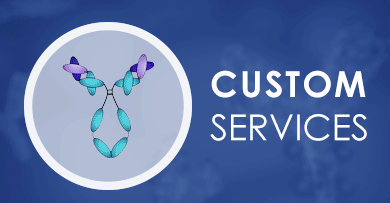 Loading...
Loading...

SLAMF7
 Loading...
Loading...Anti-SLAMF7 Products
-
- Derivation: Humanized (from mouse)
- Species Reactivity: Human
- Type: IgG1 - kappa
- Application: FuncS, IF, Neut, ELISA, FC, IP, IHC
-
- Derivation: Humanized
- Species Reactivity: Human
- Type: Human IgG
- Application: IF, IHC, Inhib
- Mouse Anti-SLAMF7 Recombinant Antibody (HPAB-AP798-YC) (HPAB-AP798-YC)
-
- Species Reactivity: Human
- Type: Mouse IgG2b
- Application: ELISA, FC, IHC, Inhib
- Human Anti-SLAMF7 Recombinant Antibody (HPAB-AP799-YC) (HPAB-AP799-YC)
-
- Derivation: Humanized
- Species Reactivity: Human
- Type: Humanized IgG1
- Application: ELISA, FC, IHC, Inhib, ADCC, FuncS
-
- Derivation: Humanized (from mouse)
- Species Reactivity: Human
- Type: ADCC enhanced antibody
- Application: FuncS, IF, Neut, ELISA, FC, IP
- Mouse Anti-SLAMF7 Recombinant Antibody (HPAB-AP796-YC) (HPAB-AP796-YC)
-
- Species Reactivity: Human
- Type: Mouse IgG1
- Application: ELISA, FC, IHC, Inhib
- Mouse Anti-SLAMF7 Recombinant Antibody (HPAB-AP797-YC) (HPAB-AP797-YC)
-
- Species Reactivity: Human
- Type: Mouse IgG2a
- Application: ELISA, FC, IHC, Inhib
-
- Derivation: Mouse
- Species Reactivity: Human
- Type: Mouse IgG1
- Application: WB, IHC
-
- Derivation: Rabbit
- Species Reactivity: Human
- Type: Rabbit IgG
- Application: ELISA, FC, IP, IF
- Human Anti-SLAMF7 Recombinant Antibody (HPAB-AP800-YC) (HPAB-AP800-YC)
-
- Derivation: Chimeric (Mouse/Human)
- Species Reactivity: Human
- Type: Chimeric (Mouse/Human) IgG1, κ
- Application: ELISA, FC, IHC, Inhib, ADCC, FuncS
-
- Derivation: Humanized
- Species Reactivity: Human
- Type: ADCC enhanced antibody
-
- Species Reactivity: Human
- Type: Mouse antibody
- Application: FC
-
- Derivation: Rabbit
- Species Reactivity: Human
- Type: Rabbit IgG
- Application: ELISA, FC, IP, IF
-
- Derivation: Rabbit
- Species Reactivity: Human
- Type: Rabbit IgG
- Application: ELISA, FC, IP, IF
-
- Type: Mouse IgG1
- Application: ELISA, WB, IHC, FC
- Mouse Anti-SLAMF7 Recombinant Antibody (VS-0224-XY118), PE (VS-0224-XY118)
-
- Species Reactivity: Human, Cynomolgus
- Type: Mouse IgG2b
- Application: FC
- AbPlus™ Anti-SLAMF7 Magnetic Beads (DM10) (VS-0424-XY237)
-
- Target: SLAMF7
- Target Species: Human
- Application: IP, Protein Purification
- Mouse Anti-SLAMF7 Recombinant Antibody; Fab Fragment (HPAB-AP796-YC-F(E)) (HPAB-AP796-YC-F(E))
-
- Species Reactivity: Human
- Type: Mouse Fab
- Application: ELISA, FC, IHC, Inhib
- Mouse Anti-SLAMF7 Recombinant Antibody; Fab Fragment (HPAB-AP797-YC-F(E)) (HPAB-AP797-YC-F(E))
-
- Species Reactivity: Human
- Type: Mouse Fab
- Application: ELISA, FC, IHC, Inhib
- Mouse Anti-SLAMF7 Recombinant Antibody; Fab Fragment (HPAB-AP798-YC-F(E)) (HPAB-AP798-YC-F(E))
-
- Species Reactivity: Human
- Type: Mouse Fab
- Application: ELISA, FC, IHC, Inhib
- Human Anti-SLAMF7 Recombinant Antibody; Fab Fragment (HPAB-AP799-YC-F(E)) (HPAB-AP799-YC-F(E))
-
- Derivation: Humanized
- Species Reactivity: Human
- Type: Humanized Fab
- Application: ELISA, FC, IHC, Inhib, ADCC, FuncS
- Human Anti-SLAMF7 Recombinant Antibody; Fab Fragment (HPAB-AP800-YC-F(E)) (HPAB-AP800-YC-F(E))
-
- Derivation: Chimeric (Mouse/Human)
- Species Reactivity: Human
- Type: Chimeric (Mouse/Human) Fab
- Application: ELISA, FC, IHC, Inhib, ADCC, FuncS
- Mouse Anti-SLAMF7 Recombinant Antibody; scFv Fragment (HPAB-AP796-YC-S(P)) (HPAB-AP796-YC-S(P))
-
- Species Reactivity: Human
- Type: Mouse scFv
- Application: ELISA, FC, IHC, Inhib
- Mouse Anti-SLAMF7 Recombinant Antibody; scFv Fragment (HPAB-AP797-YC-S(P)) (HPAB-AP797-YC-S(P))
-
- Species Reactivity: Human
- Type: Mouse scFv
- Application: ELISA, FC, IHC, Inhib
- Mouse Anti-SLAMF7 Recombinant Antibody; scFv Fragment (HPAB-AP798-YC-S(P)) (HPAB-AP798-YC-S(P))
-
- Species Reactivity: Human
- Type: Mouse scFv
- Application: ELISA, FC, IHC, Inhib
- Human Anti-SLAMF7 Recombinant Antibody; scFv Fragment (HPAB-AP799-YC-S(P)) (HPAB-AP799-YC-S(P))
-
- Derivation: Humanized
- Species Reactivity: Human
- Type: Human scFv
- Application: ELISA, FC, IHC, Inhib, ADCC, FuncS
- Human Anti-SLAMF7 Recombinant Antibody; scFv Fragment (HPAB-AP800-YC-S(P)) (HPAB-AP800-YC-S(P))
-
- Species Reactivity: Human
- Type: Human scFv
- Application: ELISA, FC, IHC, Inhib, ADCC, FuncS
-
- Species Reactivity: Mouse
- Type: IgG
- Application: ELISA
-
- Species Reactivity: Human
- Type: Mouse IgG2a, kappa
- Application: FC
-
- Species Reactivity: Human
- Type: IgG
- Application: ELISA
- Rabbit Anti-SLAMF7 Recombinant Antibody (VS13-YC1062) (VS13-YC1062)
-
- Species Reactivity: Human
- Type: Rabbit IgG
- Application: IHC-P
- Human Anti-SLAMF7 (clone Elotuzumab) scFv-Fc Chimera (VS-0425-FY183)
-
- Species Reactivity: Human
- Type: Human IgG1, scFv-Fc
- Application: ELISA, FC
-
- Species Reactivity: Human
- Target: SLAMF7
- Host Animal: Mouse
- Application: ELISA, FC, Neut, Cell-uptake
- Anti-SLAMF7 Immunohistochemistry Kit (VS-0525-XY6620)
-
- Species Reactivity: Human
- Target: SLAMF7
- Application: IHC
-
- Derivation: Humanized
- Species Reactivity: Human
- Type: Human IgG2a
- Application: Activation
Can't find the products you're looking for? Try to filter in the left sidebar.Filter By Tag
Our customer service representatives are available 24 hours a day, from Monday to Sunday. Contact Us
For Research Use Only. Not For Clinical Use.
Background

CD markers, FDA approved drug targets
Intracellular, Membrane (different isoforms)
Cell type enhanced (Plasma cells, monocytes, NK-cells, dendritic cells)
Low immune cell specificity
Cell line enriched (U-266/70)
Isoform 1 binds to SH2D1A when its cytoplasmic tail is phosphorylated in the presence of FYN (in vitro); low affinity binding, the physiological relevance of the interaction is questioned. Interacts with SH2D1B; in NK cells (PubMed:16339536). Interacts (via ITSM phosphorylated on Tyr-302) with SH2D1B, PTPN6/SHP-1, PTPN11/SHP-2, INPP5D/SHIP1, CSK and FYN (By similarity).
Receptor



